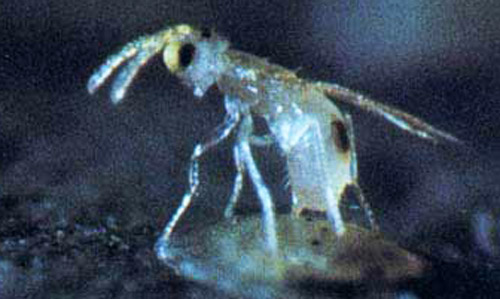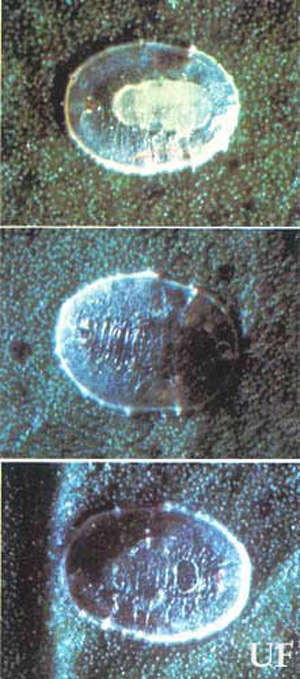common name: a citrus whitefly parasitoid
scientific name: Encarsia lahorensis (Howard) (Insecta: Hymenoptera: Aphelinidae)
Introduction - Distribution - Description and Biology - Host - Selected References
Introduction (Back to Top)
Encarsia lahorensis (Howard) is a specific parasitoid of the citrus whitefly, Dialeurodes citri (Ashmead). This parasitoid was discovered on citrus whitefly by R.S. Woglum, in 1911, while searching for natural enemies in India (Woglum 1913). Attempts were made to introduce Encarsia lahorensis into Florida in 1911, however, cultures arrived in December when few susceptible host stages were available and the parasite was not able to survive (Woglum 1913). Apparently, no further attempts were made to introduce this parasite into Florida for the control of citrus whitefly until 1977.
In May 1977, the author transported Encarsia lahorensis to Florida from California where it was established. Subsequently, it became established in Alachua and Polk counties, Florida (Nguyen and Sailer 1979). By the summer of 1979, Encarsia lahorensis had suppressed the citrus whitefly population on viburnum and gardenia in those counties. Because of this success, 800 potted gardenia plants infested by citrus whitefly nymphs were exposed to Encarsia lahorensis. After becoming parasitized these whiteflies and plants were distributed to 66 of 67 Florida counties. Field surveys during 1981-82 indicated the presence of established populations of Encarsia lahorensis in 59 counties (Sailer et al. 1984).
Figure 1. Citrus whitefly parasite, Encarsia lahorensis Howard, ovipositing in an immature citrus whitefly. Photograph by University of Florida.
Distribution (Back to Top)
Encarsia lahorensis has been reported as native to India and Pakistan (Woglum 1913), and introduced to California in 1966 (Rose and DeBach 1981), Florida in 1977 (Nguyen and Sailer 1979), Georgia, Alabama, Texas, Louisiana, North Carolina (Wendel, personal communication), Italy (Viggiani and Mazzone 1978), and Israel (Rossler, personal communication) for controlling the citrus whitefly.
Description and Biology (Back to Top)
The female is small (0.54 to 0.84 mm long, 1.42 mm wing span), body white, head yellow, antennae with segments, funicule segment longer than wide (three times as long as wide), wing without shading in median. The male is a little smaller than female (0.62 mm long), and different in color, head brown, and abdomen dark brown (Howard 1911, Grissell 1979). Under experimental conditions (26±1ºC, 70% Rh) longevity of the female is nine days; male, eleven days; and unfed adults, three days. Mated females deposited fertilized eggs in 3rd and 4th nymphal stages of Dialeurodes citri and produced female offspring. Virgin females laid unfertilized eggs in the body of female fully- developed larvae or pupae of their own species (adelphoparasitic insect) and produced male offspring. Under laboratory conditions the development from egg to adult at 24ºC required 12 to 15 days for males and 24 to 25 days for females (Nguyen and Sailer 1979, Viggiani and Mazzone 1978). Encarsia lahorensis overwinters at various stages (larva, pupa). However, it has high mortality during winter in North Florida, especially for the first larval stage. The sex ratio changed from generation to generation. During the main period of adult emergence in March through April in Central Florida, the sex ratio favored females, but the number of males gradually increased later.
Host (Back to Top)
Encarsia lahorensis is a specific parasitoid and Dialeurodes citri is the only host reported.
Figure 2. Top: immature larva of the parasite, Encarsia lahorensis Howard, in a larva of a citrus whitefly, Dialeurodes citri (Ashmead); middle: Encarsia lahorensis pupa in citrus whitefly larva; bottom: emergence hole of an adult Encarsia lahorensis in a dead citrus whitefly larva. Photograph by University of Florida.
Selected References (Back to Top)
- Grissell EE. 1979. The Prospaltella of Florida. Florida Department of Agriculture and Consumer Services, Division of Plant Industry Entomology Circular 203. p. 1-4.
- Howard LO. 1911. A note on the Indian enemies of Aleyrodes citri R. & H., with description of a new species of Prospaltella. Journal of Economic Entomology 4: 130-132.
- Nguyen Ru, Sailer RI. 1979. Colonization of a citrus whitefly parasite, Prospaltella lahorensis, in Gainesville, Florida. Florida Entomologist 62: 59-65.
- Rose M, DeBach P. 1981. Citrus whitefly parasites established in California. California Agriculture 35: 21-23.
- Sailer RI, Brown RE, Munir B, Nickerson JCE. 1984. Dissemination of the citrus whitefly (Homoptera: Aleyrodidae) parasite Encarsia lahorensis (Howard) (Hymenoptera: Aphelinidae) and its effectiveness as a control agent in Florida. Bulletin of the Entomological Society of America 30: 36-39.
- Viggiani G, Mazzone P. 1978. Morfologia, biologia e utilizzazione di Prospaltella lahorensis How. (Hym.: Aphelinidae), a parassita esotico introdotto in Italia per la lotta biologia al Dialeurodes citri (Ashm.). Boll. Lab. Entomol. Agro. "F. Silvestri" Portici. 35: 99-161.
- Woglum RS. 1913. Report of a trip to India and the Orient in search of the natural enemies of the citrus whitefly. USDA Bureau of Entomology Bulletin 120: 1-58.

